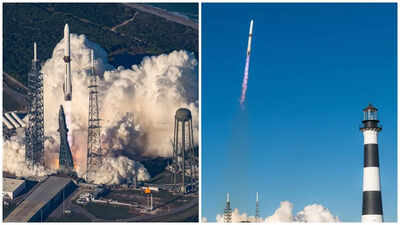
Blue Origin successfully launched its huge New Glenn rocket on Thursday from Cape Canaveral Space Force Station, sending two Nasa spacecraft on a mission to Mars. In a post on X, Blue Origin wrote, “New Glenn successfully completed its second mission by deploying @NASA’s ESCAPADE twin spacecraft, powering on and transmitting data for @Viasat’s HaloNet technology demonstration, and landing the fully reusable first stage on Jacklyn.”The 321-foot (98-metre) rocket carried the twin orbiters, named Escapade, in a drawn-out journey towards the red planet. Following booster separation, Blue Origin achieved a first by recovering the booster on a barge 375 miles offshore, cheered on by company employees, AP reported.Liftoff was delayed by four days owing to poor weather and intense solar storms, which painted the skies with auroras as far south as Florida. Twenty minutes after launch, the rocket’s upper stage deployed the Mars orbiters, marking the mission’s primary objective. “Next stop, moon!” employees chanted after the booster’s bull’s-eye landing, as congratulations poured in from Nasa officials and SpaceX’s Elon Musk.The identical orbiters will spend one year near Earth at a distance of 1 million miles (1.5 million kilometres). When Earth and Mars align next fall, they will use a gravity assist to reach Mars in 2027. Once in orbit, they will map Mars’s upper atmosphere and magnetic fields and study their interaction with the solar wind. Scientists expect the observations to reveal how Mars’s atmosphere escaped and to inform radiation protection for future astronauts. “We really, really want to understand the interaction of the solar wind with Mars better than we do now,” Escapade’s lead scientist, Rob Lillis of the University of California, Berkeley, said ahead of the launch. “Escapade is going to bring an unprecedented stereo viewpoint because we’re going to have two spacecraft at the same time.”The low-budget mission, managed and operated by UC Berkeley, cost under $80 million. Nasa reduced costs by booking an early New Glenn flight. The orbiters were originally slated to launch last fall, but Nasa passed up that window because of anticipated delays with Blue Origin’s new rocket.Named after John Glenn, the first American to orbit Earth, New Glenn is five times larger than Blue Origin’s New Shepard vehicles. The company plans to launch a prototype Blue Moon lunar lander on New Glenn in the coming months. Founded in 2000 by Jeff Bezos, Blue Origin already holds a Nasa contract for the third crewed moon landing under the Artemis programme. SpaceX won contracts for the first two crewed landings with its taller Starship rockets.Last month, Nasa acting administrator Sean Duffy reopened the contract for the first crewed moon landing, citing concerns over Starship’s flight-test pace. Both Blue Origin and SpaceX have since presented accelerated landing plans. NASA is on track to send astronauts around the moon early next year on its Space Launch System rocket, with the next Artemis crew aiming to land by the end of the decade to beat China back to the lunar surface.








